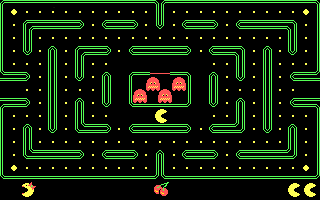Monitor
A Monitor is a computer peripheral that allows you to see what is actually happening in a computer. You are most likely reading this on a monitor right now. It's the glowing thing in front of you with words. In fact, if you are on a computer and you are unsure what a monitor is, then you're amazingly slow.
Monitors were designed to be used with computers for three purposes: Games, Pornography, and Web surfing.
Monochrome monitors
Monochrome, or monochromatic monitors, were the first type of computer TVs introduced by IBM with the personal computer. Designed primarily for the display of text, these monitors could generally handle a graphics size of 40 characters by 25 characters, or 40*25.
This of course limited graphic capabilities dramatically, and as such extremely limited early computer porn.
Computer games at the time adapted by using character graphics as opposed to raster graphics in order to simulate action. A very successful early arcade game was pong, based around the game ping pong, or how the Chinese say: ping pong.
One of the first successful tie-ins with a celebrity and a computer game was John McEnroe Pong. John McEnroe was something of a wild boy on the tennis court, and was renowned for his aggression towards the match referees.
| Screenshot of John McEnroe Pong |
And of course another popular innovation that came along with the advent of the personal computer was the World Wide Web.
Unfortunately, due to the graphic capabilities of computers at the time, this did take a while to really take off.
Color Graphics Adapter (CGA)
The next great leap was moving from a 2 color palette to a 16 color palette. Of course this did involve taking up a significantly higher amount of on-board RAM in order to be able to produce this result. So IBM decided to add a huge 16kb of video RAM in order to make this possible.
This allowed the user to choose between two text modes. The 40 * 25 character resolution was kept intact with the full 16 color spectrum that CGA could handle, which meant that it remained reverse compatible with the monochrome monitors of the days gone by. CGA also allowed the user to choose the huge resolution of 80 X 25 characters, which worked out as a gigantic 640 * 200 pixels.
However, CGA also demanded a different mode for graphics. Again the user could choose between 320 * 200 pixels or 640 * 200 pixels, but the trade-off for this of course was that in order to be able to handle the intense calculations that this resolution demanded, the user had an option of one of several color palettes.
| # | Normal intensity | High intensity | ||
|---|---|---|---|---|
| Palette 1 | Palette 0 | Palette 1 | Palette 0 | |
| 0 | (0) Default black | (0) Default black | (0) Default black | (0) Still black |
| 1 | (2) Pea vomit green | (3) Dirty water cyan | (10) Pus green | (11) Clear water cyan |
| 2 | (4) Blood red | (5) Ugly magenta | (12) Red-eye red | (13) Girly pink |
| 3 | (6) Baby shit brown | (7) Dirty white | (14) Pee yellow | (15) Pearly white |
- The number in parenthesis is the color number used when programming graphics
One of the other innovations that was brought in with CGA was the further 16 "blinking" colors. By adding 16 to the standard color number, this allowed the colors to blink on and off. This of course was an extremely annoying feature and as such was removed from later graphics cards.
Given this huge range in color possibilities, this dramatically increased the capacity to view porn, and as such a large number of images now flooded the Internet of naked and semi-clad women. With the extremely high realism of these images (such as the one on the right done on high intensity palette 0), the Internet started going through its first boom time. Of course, at this stage most IBM PCs did not have a mouse attached which did create issues when attempting to browse.
As the graphics capabilities increased, games had the capacity to take the next quantum leap forward in capacity.
One game that has arguably withstood the test of time is undoubtedly Pacman. Spawning a franchise that is still producing titles today, the basic gameplay has barely changed. Rare original copies produced prior to the industry introducing a compulsory ratings system that removed adult elements from the game are still in circulation.
Enhanced Graphics Adapter (EGA)
Intelligent computer users now started to realise that IBM was being stingy in regard to the graphics capabilities as their monitors could display 16 colours, so why weren't they being allowed to display them all at once? It was at this stage that they realised that in order to do so all IBM needed to do was increase the capacity of the colour graphics adapter by moving it from 4 bits per colour to 6 bits per colour.
Responding to customer demand, IBM decided to throw their two bits in and created EGA, with a whopping 16 colours in graphics mode and a huge 64 colours in text mode. This was a huge leap forward in computer technology and allowed users to start to work in much more lifelike colours.
One such user was Mark Zuckerberg, who used the new colour technology to create the social networking site the facebook. At first he was the only one on the site who had created a profile for himself, but he did not allow this to daunt him.
As with all other graphics improvements, this lead to an improvement in pornography available in the computer. Of course this increase in realism also called for a much stronger increase in censorship of what was available on computers in relation to computer graphics.
As brave as this attempt was, for the most part it failed to gain much of a foothold in the community. There are elements, however, that still believe that the improvement of computers graphics is a bad thing.
There are also some elements that believe that the earth is flat. They are often the same elements.
Of course with every improvement in graphics the games capacity of computers increased as well. As the world neared the end of the cold war, a plucky Russian by the name of Alexi Pajitnoviskidoscha, or something similar, created a game that he named Tetris which involved a number of falling blocks being placed to make complete lines.
This caused some issues with the Russian government. They wanted to prove their intellectual superiority in being able to produce a computer game that stretched the capacity of the new graphics systems to their very limit. However, some levels, such as the now infamous Berlin Wall level, were considered to be too seditious to be allowed to be released, and as such were removed from all games after the beta version.
Video Graphics Array (VGA)
VGA was the last graphics standard that IBM introduced, and is now considered to be the lowest common denominator of graphics standards. This did away with the concept of fixed width characters and allowed for the introduction of new fonts that could have a range of widths for each letter.
One of the issues with VGA was that while it allowed a usage of 256 colours on a 320 * 200 pixel screen, on higher resolutions (up to an amazing 640 * 480 pixels) it only allowed the use of 16 colours. This meant that although this allowed higher resolution graphics, it did so at a cost of the resolution of the image, the result of which caused some issues.
| VGA allowed the standard EGA palette of 16 colours at higher resolution graphics (640 * 480 pixels) | VGA also allowed the larger palette of 256 colours at lower resolution graphics (320 * 200 pixels) |
This of course meant that the once popular Bikini Girl image was now relegated to a long lost memory, and that new images would have to be created. Distributors of higher quality adult computer graphics have since attempted to meet this demand, although it appears that there is a significant absence of any pornographic material available on the Internet.
The Internet started to gain popularity at this stage, with IBM introducing Microsoft Windows. This was the IBM equivalent of the Apple's operating system which had for many years been a Graphical User Interface (GUI) system. Windows is now known to be one of the most stable computer systems available in the market and lacks any flaws. [citation needed]
Given this extremely powerful graphics capacity, game designers worked to bring into the market one of the most popular games today - Wolfenstein 3D. Combining the aggressive elements of earlier successes like McEnroe Pong, the maze aspects of games like Pacman, and the underlying hatred of Germans as shown in Tetris, Wolfenstein is a game that has continued to grow in stature.










